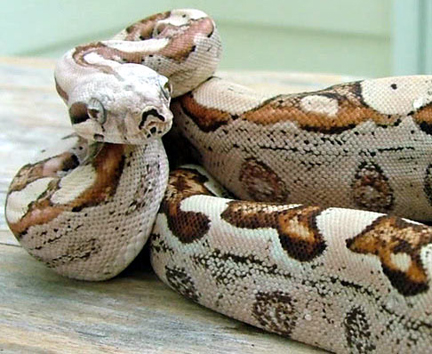



Unique Reptile Parties and Shows
Snakes, Lizards, Giant Tortoises and Crocs
07792491044

BOA CONSTRICTOR
 The Boa constrictor is a large, heavy-bodied species of snake. It is a member of
the family Boidae found in North, Central, and South America, as well as some islands
in the Caribbean. A staple of private collections and public displays, its colour
pattern is highly variable yet distinctive. Ten subspecies are currently recognized,
although some of these are controversial. These pages focus on the species Boa constrictor
as a whole, but also specifically on the nominate subspecies Boa constrictor constrictor.
The Boa constrictor is a large, heavy-bodied species of snake. It is a member of
the family Boidae found in North, Central, and South America, as well as some islands
in the Caribbean. A staple of private collections and public displays, its colour
pattern is highly variable yet distinctive. Ten subspecies are currently recognized,
although some of these are controversial. These pages focus on the species Boa constrictor
as a whole, but also specifically on the nominate subspecies Boa constrictor constrictor.
Though all boids are constrictors, only this species is properly referred to as "Boa constrictor"; a rare instance of an animal having the same common and scientific binomial name. (The distinction is shared with Tyrannosaurus rex.) All subspecies are referred to as "Boa constrictors", while the nominate subspecies, boa constrictor, is often referred to specifically as the "red-tailed boa". Within the exotic pet trade it is also known as a "BCC", an abbreviation of its scientific name, to distinguish it from other Boa constrictor subspecies such as the Boa constrictor imperator which is also regularly, and erroneously, referred to as a "red-tailed boa" or "common boa". Other common names include "chij-chan" (Mayan), "jibóia" (Latin American) and "macajuel" (TriThe Boa constrictor is a large snake, although only modestly sized in comparison to other large snakes such as the reticulated python and Burmese python, and can reach lengths of anywhere from 3–13 feet (0.91–4.0 m) depending on the locality and the availability of suitable prey. There is clear sexual dimorphism seen in the species, with females generally being larger in both length and girth than males. As such, the average size of a mature female boa is between 7–10 feet (2.1–3.0 m), whilst it is 6–8 feet (1.8–2.4 m) for the males. It is common for female individuals to exceed 10 feet (3.0 m), particularly in captivity, where lengths of up to 12 feet (3.7 m) or even 14 feet (4.3 m) can be seen. A report of a Boa constrictor growing up to 18.5 feet (5.6 m) was later found to be a misidentified green anaconda.
The Boa constrictor is a heavy-bodied snake, and large specimens can weigh up to 27 kg (60 lb). Females, the larger sex, more commonly weigh 10 to 15 kg (22 to 33 lb).[9] Some specimens of this species can reach or possibly exceed 45 kg (99 lb), although this is not usual.
The size and weight of a Boa constrictor depends on subspecies, locale, and the availability of suitable prey. Several populations of Boa constrictors are known as "dwarf boas", such as the population of boa constrictor imperator on Hog Island. These smaller subspecies are generally insular populations. Boa constrictor itself reaches, and occasionally tops, the averages given above, as it is one of the relatively large subspecies of Boa constrictor. Other examples of sexual dimorphism in the species include the fact that males generally have longer tails to contain the hemipenes and also longer pelvic spurs, which are used to grip and stimulate the female during copulation.[11] Pelvic spurs are the only external sign of the rudimentary hind legs and pelvis, seen in all boas and pythons.
The coloring of Boa constrictors can vary greatly depending on the locality. However, they are generally a brown, grey or cream base color, patterned with brown or reddish brown "saddles" that become more pronounced towards the tail. It is this coloring that gives Boa constrictor constrictor the common name of "red-tailed boa", as it typically has more red saddles than other Boa constrictor subspecies. The coloring works as very effective camouflage in the jungles and forests of its natural range.
There are also individuals that exhibit pigmentary disorders such as albinism. Although these individuals are rare in the wild, they are common in captivity where they are often selectively bred to make a variety of different color "morphs". Boa constrictors have an arrow-shaped head that has very distinctive stripes on it. One runs dorsally from the snout to the back of the head. The others run from the snout to the eyes and then from the eyes to the jaw. Juvenile South American boa constrictor
Boa constrictors can sense heat via cells in their lips, though they lack the labial pits surrounding these receptors seen in many members of the boidae family. Boa constrictors also have two lungs, a smaller (non-functional) left and enlarged (functional) right lung to better fit their elongated shape, unlike many colubrid snakes which have completely lost the left lungnidadian).
Dependent on subspecies Boa constrictor can be found from northern Mexico through Central America (Belize, Guatemala, Honduras, El Salvador, Nicaragua, Costa Rica and Panama) to South America north of 35°S (Colombia, Ecuador, Peru, Venezuela, Trinidad and Tobago, Guyana, Suriname, French Guiana, Brazil, Bolivia, Uruguay and Argentina). Also in the Lesser Antilles (Dominica and St. Lucia), on San Andrés, Providencia and many other islands along the coasts of Mexico and Central and South America.
Prey includes a wide variety of mammals and birds. The bulk of their diet consists of rodents, but larger lizards and mammals as big as ocelots are also reported to have been consumed. Young Boa constrictors will eat small mice, birds, bats, lizards and amphibians. The size of the prey item will increase as they get older and larger. Boa constrictors are ambush predators and as such will often lie in wait for an appropriate prey to come along at which point they will attack. However, they have also been known to actively hunt, particularly in regions with a low concentration of suitable prey, and this behaviour generally occurs at night. The boa will first strike at the prey, grabbing it with its teeth, it then proceeds to constrict the prey until death before consuming it whole. Their teeth also help force the animal down the throat whilst muscles then move it towards the stomach. It will take the snake approximately 4–6 days to fully digest the food, depending on the size of the prey and the local temperature. After this the snake may not eat for anywhere from a week to several months, due to its slow metabolism. Boa constrictors are ovoviviparous, giving birth to live young. They will generally breed in the dry season—between April and August—and are polygynous, thus males may mate with multiple females. A half of all females will breed in a given year, and a larger percentage of males will actively attempt to locate a mate. However due to the polygynous nature of Boa constrictor many of these males will be unsuccessful. The reasoning being the fact that they are ovovivparous (i.e. eggs hatching inside the body). As such female boas without a good enough physical condition will be unlikely to attempt to mate, nor produce viable young if they do mate. In 2010, a boa constrictor was shown to have reproduced asexually via parthenogenesis.
During breeding season the female boa will emit a scent from her cloaca to attract males, who may then wrestle for the right to breed with her. During breeding the male will curl his tail around the female's and the hemipenes (or, male reproductive organs) will be inserted. Copulation can last from a few minutes to several hours, and may occur several times over a few week periods. After this period ovulation may not occur immediately, however the female can hold the sperm inside her for up to one year. When the female ovulates, a mid-body swell can be noticed that appears similar to after the snake has eaten a large meal. The female will then shed two to three weeks after ovulation, with what is known as a post ovulation shed which will last another 2–3 weeks, which is longer than a normal shed. The gestation period, which is counted from the post ovulation shed, is approximately 100–120 days. The female will then give birth to young that average 15–20 inches (38–51 cm) in length. The litter size varies between females, but can be between 10 and 65 young with an average of 25, although some of the young may be still-borns or non-fertilised eggs known as "slugs". The young are independent at birth and will grow rapidly for the first few years, shedding regularly (once every one to two months). At between 3–4 years Boa constrictors become sexually mature and will have reached the adult size of between 6–10 ft, although they will continue to grow at a slow rate for the rest of their lives. At this point they will shed less frequently, approximately every 2–4 months.